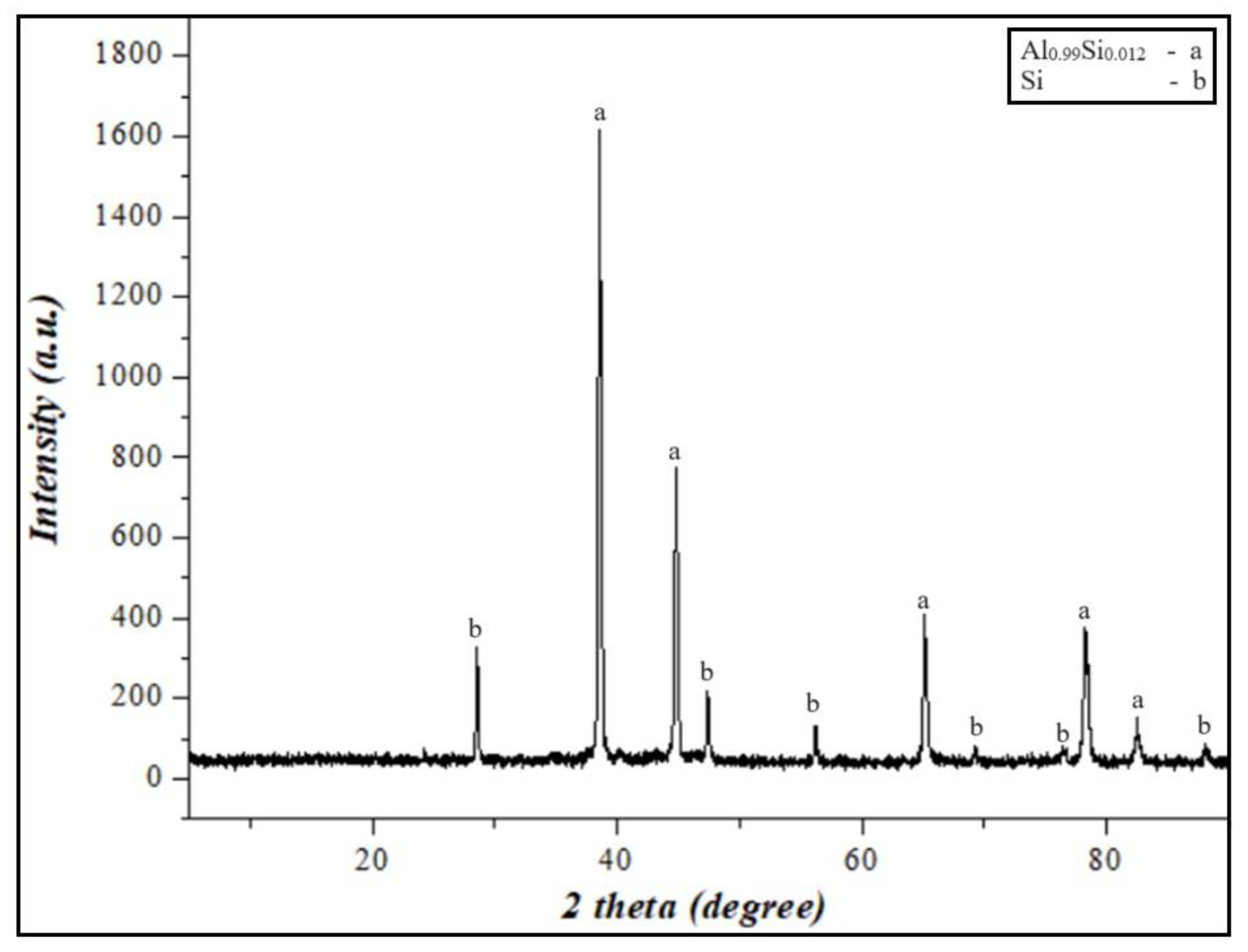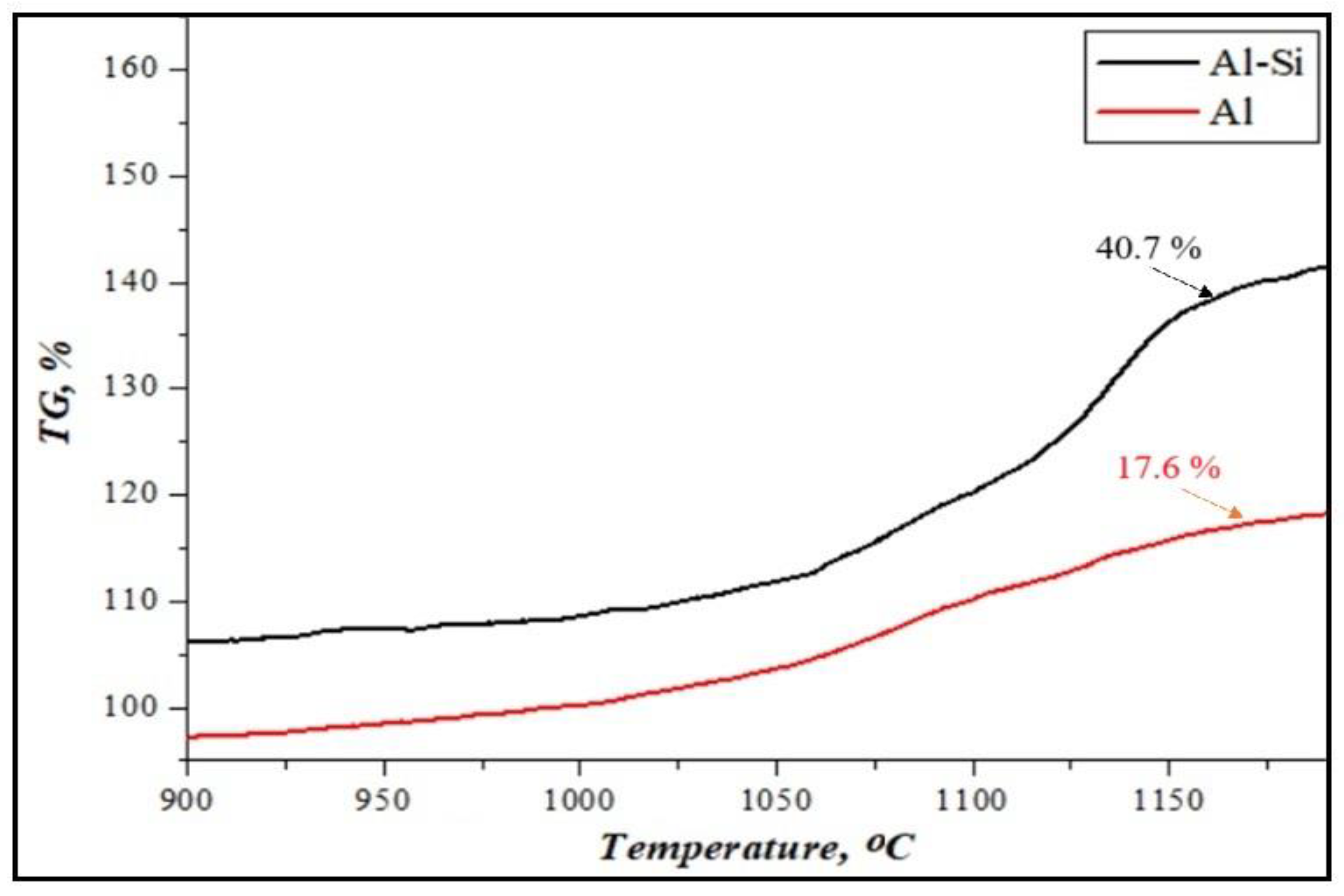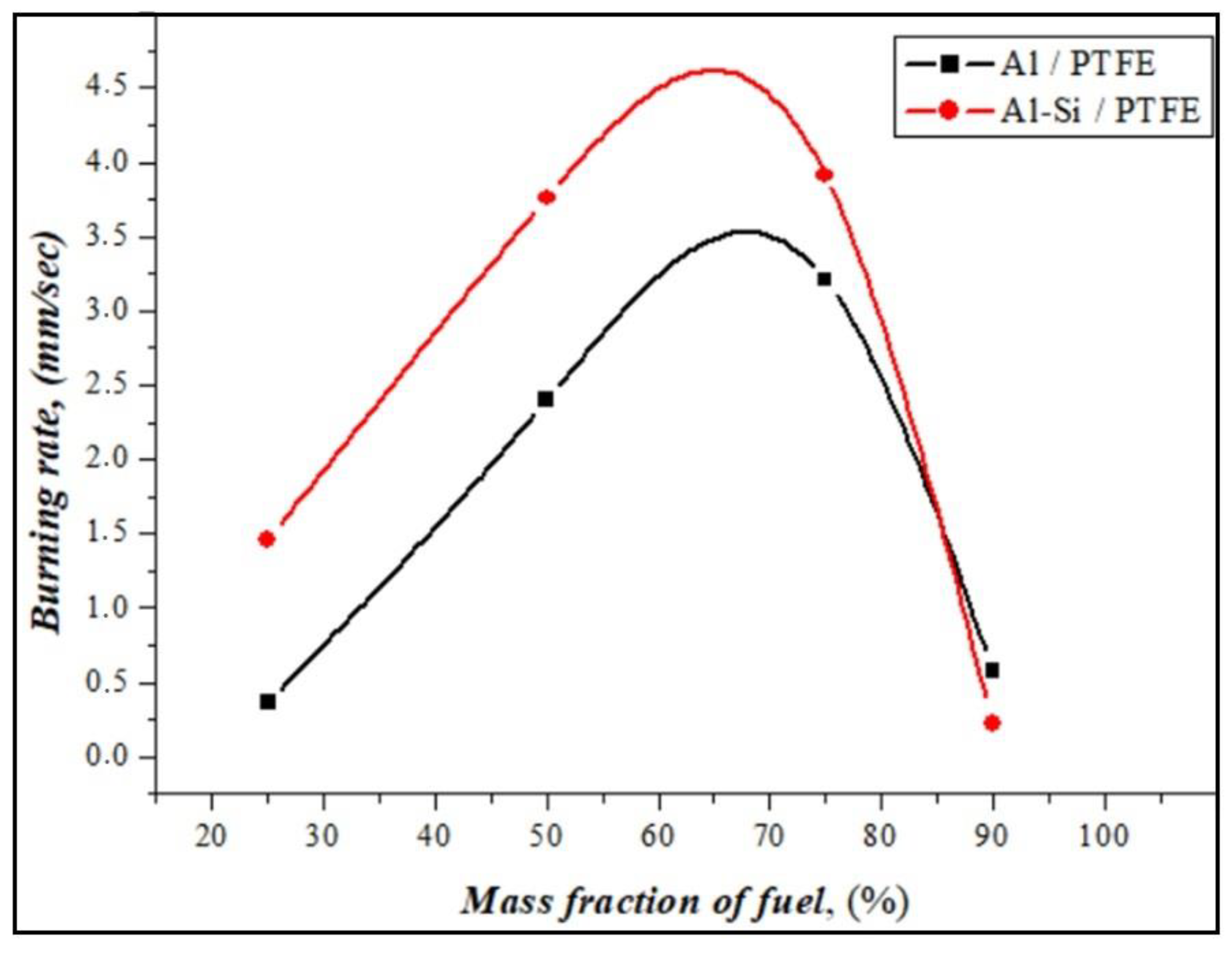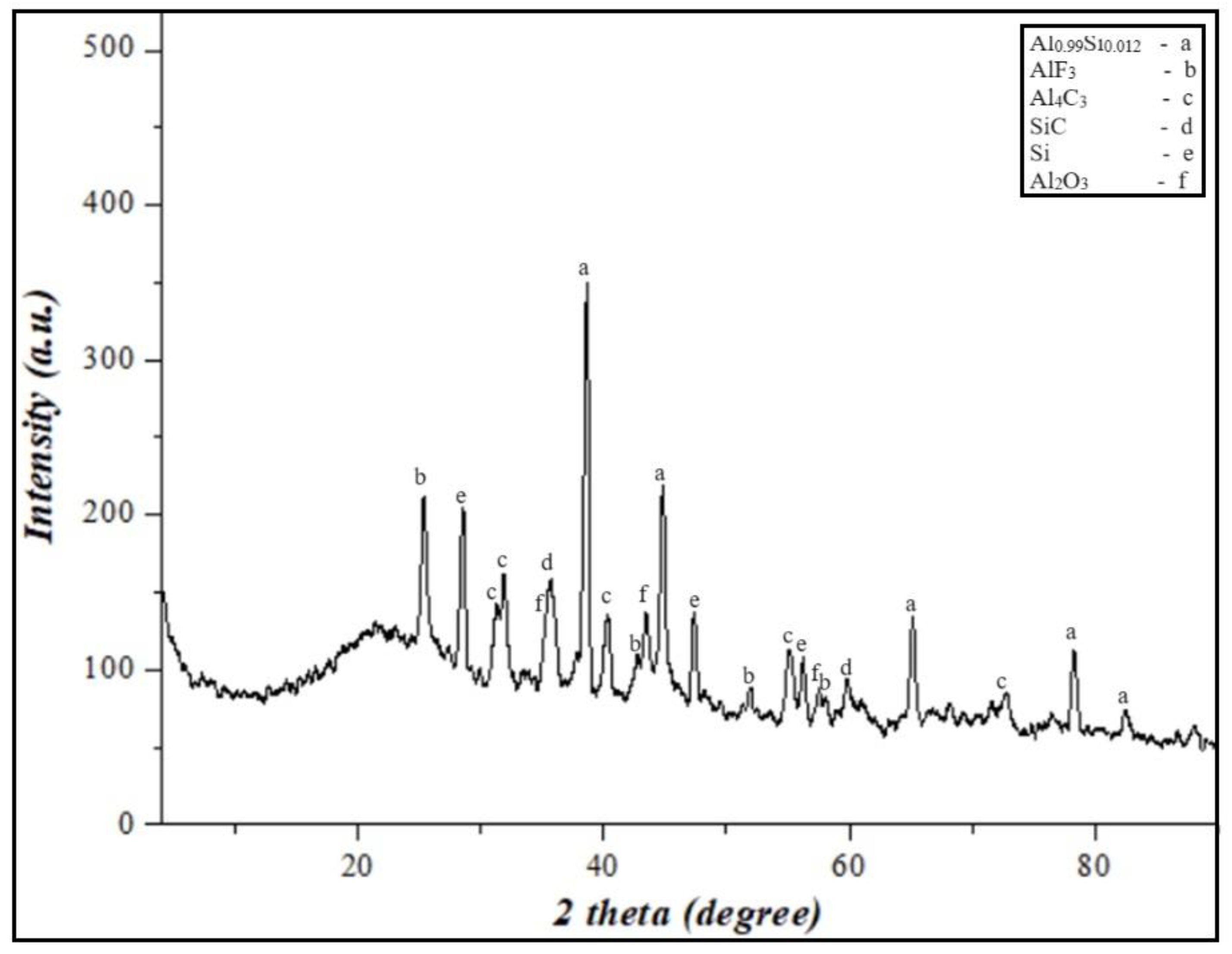Enhanced Combustion Properties of Al-Si Eutectic Alloy in Energetic Mixtures
Abstract
1. Introduction
2. Materials and Methods
2.1. Materials
2.2. Research Instruments
2.3. Measurement of Thermal Properties of Initial Components and Energetic Mixtures
2.4. Preparation of Al-Si Alloy-Based Powders
2.5. Preparation of PTFE/Al-Si-Based Energetic Mixtures
3. Results and Discussion
3.1. Preparation of Al-Si Alloy Powder
3.2. Morphology and Composition of Al and Al-Si-Based Alloy Fuels
3.3. Application of Al-Si Alloy Reactive Fuels in Energetic Mixture
4. Conclusions
- (1)
- Al-Si eutectic alloy powder was obtained from economically viable secondary resources and reduced to optimum size by mechanical processing.
- (2)
- The activation energy of Al-Si alloy powders (84.72 kJ/mol) was significantly lower than that of pure aluminum powder (494.36 kJ/mol), because silicon in the alloy lowers the energy required for the initial ignition of jet fuels, and the oxide film on the surface of a pure aluminum particle significantly increases the thermal decomposition temperature. In addition, it can be assumed that scratches, cracks, and deformations during the mechanical grinding of secondary materials reduce the activation energy.
- (3)
- Due to the physicochemical advantages of Al-Si eutectic alloy powder compared to pure aluminum powder, the burning characteristics of PTFE-based energetic mixtures have been improved. In comparison, the burning rate of energetic mixtures prepared with the Al-Si eutectic alloy was 1.5–2.0 mm/s higher than mixtures prepared with pure aluminum.
- (4)
- Oxides, carbides, and fluorides formed when reactive fuels based on Al-Si are burned in energy mixtures are products of high-temperature exothermic chemical reactions. These reactions positively affect the burning kinetics and thermodynamics of energetic mixtures.
Author Contributions
Funding
Institutional Review Board Statement
Informed Consent Statement
Data Availability Statement
Conflicts of Interest
References
- Sadeghipour, S.; Ghaderian, J.; Wahid, M.A. Advances in aluminum powder usage as an energetic material and applications for rocket propellant. AIP Conf. Proc. 2012, 1440, 100–108. [Google Scholar] [CrossRef]
- DeLuca, L.T. Overview of Al-based nanoenergetic ingredients for solid rocket propulsion. Def. Technol. 2018, 14, 357–365. [Google Scholar] [CrossRef]
- Zygmunt, A.; Gańczyk, K.; Kasztankiewicz, A.; Cieślak, K.; Gołofit, T. Application and properties of aluminum in primary and secondary explosives. J. Elem. 2017, 22, 747–759. [Google Scholar] [CrossRef]
- Pourmortazavi, S.M.; Hajimirsadeghi, S.S.; Kohsari, I.; Fathollahi, M.; Hosseini, S.G. Thermal decomposition of pyrotechnic mixtures containing either aluminum or magnesium powder as fuel. Fuel 2008, 87, 244–251. [Google Scholar] [CrossRef]
- DeLuca, L.T.; Maggi, F.; Dossi, S.; Fassina, M.; Paravan, C.; Sossi, A. Prospects of Aluminum Modifications as Energetic Fuels in Chemical Rocket Propulsion. In Chemical Rocket Propulsion, 1st ed.; Chapter: 8; Springer International Publishing: Cham, Switzerland, 2017. [Google Scholar] [CrossRef]
- Liao, X.; Liang, D.; Wang, F.; Xie, P.; Chen, Y.; Liu, J. Combustion and energy performance of multiple aluminum-based alloy particles. Combust. Flame 2024, 269, 113666. [Google Scholar] [CrossRef]
- Zhang, S.; Dreizin, E.L. Reaction Interface for Heterogeneous Oxidation of Aluminum Powders. J. Phys. Chem. C 2013, 117, 14025–14031. [Google Scholar] [CrossRef]
- Xiang, R.Z.; Ning, F.W.; Lei, H.; Rui, X.; Chao, Q.X.; Wen, B.Z.; Bao, L.S. Investigation on burning behaviors of aluminum agglomerates in solid rocket motor with detailed combustion model. Acta Astronaut. 2023, 206, 243–256. [Google Scholar] [CrossRef]
- Yagodnikov, D.A.; Ignatov, A.V.; Gusachenko, E.I. Ignition and combustion of pyrotechnic compositions based on microsized and ultra-nanosized aluminum particles in a moist medium in a two-zone gas generator. Combust. Explos. Shock Wave 2017, 53, 15–23. [Google Scholar] [CrossRef]
- Xing, H.L.; Hong, B.P.; Xu, Z.; Xian, X.Z. Effect of Aluminum Particle Size on the Performance of Aluminized Explosives. Propellants Explos. Pyrotech. 2020, 45, 807–813. [Google Scholar] [CrossRef]
- Fukuchi, A.B. Effect of aluminum particle size on agglomeration size and burning rate of composite propellant. J. Therm. Sci. Technol. 2022, 17, 21-00346. [Google Scholar] [CrossRef]
- Khaing, H.Y.; Kywe, T.T. Production of fine aluminum powder from metallic aluminum. In Proceedings of the 5th PSU-UNS International Conference on Engineering and Technology (ICET-2011), Phuket, Thailand, 2–3 May 2011; pp. 47–51. [Google Scholar]
- Pesiri, D.; Aumann, C.E.; Bilger, L.; Booth, D.; Carpenter, R.D.; Dye, R.; O Neill, E.; Shelton, D.; Walter, K.C. Industrial Scale Nano Aluminum Powder Manufacturing. J. Pyrotech. 2004, 19, 19–31. [Google Scholar]
- Quazi, M.M.; Fazal, M.A.; Haseeb, A.S.M.A.; Farazila, Y.; Masjuki, H.H.; Arslan, A. Laser-based Surface Modifications of Aluminum and its Alloys. Crit. Rev. Solid State Mater. Sci. 2016, 41, 106–131. [Google Scholar] [CrossRef]
- Jallo, L.J.; Schoenitz, M.; Dreizin, E.L.; Dave, R.N.; Johnson, C.E. The effect of surface modification of aluminum powder on its flowability, combustion and reactivity. Powder Technol. 2010, 204, 63–70. [Google Scholar] [CrossRef]
- Kamunur, K.; Jandosov, J.M.; Abdulkarimova, R.G.; Hori, K.; Yelemessova, Z.K. Combustion Study of Different Transitional Metal Oxide based on AN/MgAl Composites Gas Generators. Eurasian Chem.-Technol. J. 2017, 19, 341–346. [Google Scholar] [CrossRef]
- Liu, L.; Ao, W.; Wen, Z.; Wang, Y.; Long, Y.; Liu, P.; He, G.; Li, L.K. Modifying the ignition, combustion and agglomeration characteristics of composite propellants via Al-Mg alloy additives. Combust. Flame 2022, 238, 111926. [Google Scholar] [CrossRef]
- Shoshin, Y.L.; Dreizin, E.L. Particle combustion rates for mechanically alloyed Al–Ti and aluminum powders burning in air. Combust. Flame 2006, 145, 714–722. [Google Scholar] [CrossRef]
- Jian, K.Z.; Feng, Q.Z.; Hui, L.; Zhi, F.Y.; Ming, Z.; Yan, J.Y.; Qing, P.; Ying, W.; Xue, L.C.; Zhao, Q. Improving ignition and combustion performance of Al@Ni in CMDB Propellants: Effect of nickel coating. Chem. Eng. J. 2023, 456, 141010. [Google Scholar] [CrossRef]
- Lagoviyer, O.S.; Schoenitz, M.; Dreizin, E.L. Effect of milling temperature on structure and reactivity of Al–Ni composites. J. Mater. Sci. 2017, 53, 1178–1190. [Google Scholar] [CrossRef]
- Zhou, X.; Huang, L.; Liu, X.; Yu, H. Combustion characteristics of Al-Li alloy powder and its application in solid propellant. J. Phys. Conf. Ser. 2023, 2478, 032067. [Google Scholar] [CrossRef]
- Terry, B.C.; Gunduz, I.E.; Pfeil, M.A.; Sippel, T.R.; Son, S.F. A Mechanism for Shattering Microexplosions and Dispersive Boiling Phenomena in Aluminum–Lithium Alloy Based Solid Propellant. Proc. Combust. Inst. 2017, 36, 2309–2316. [Google Scholar] [CrossRef]
- Xiong, W.; Liu, Y.; Zhang, T.; Wu, S.; Zeng, D.; Guo, X.; Pang, A. Effect of Al–Li Alloy on the Combustion Performance of AP/RDX/Al/HTPB Propellant. Aerospace 2023, 10, 222. [Google Scholar] [CrossRef]
- Breiter, A.L.; Mal’tsev, V.M.; Popov, E.I. Means of Modifying Metallic Fuel in Condensed Systems. Combust. Explos. Shock Waves 1990, 26, 86–92. [Google Scholar] [CrossRef]
- Xu, D.; Li, S.; Jin, X.; Huang, X.; Li, H.; Wang, F. Comparison on the ignition and combustion characteristics of single Al-Li alloy and Al fuel microparticles in air. Combust. Flame 2023, 258, 113114. [Google Scholar] [CrossRef]
- Ao, W.; Fan, Z.; Liu, L.; An, Y.; Ren, J.; Zhao, M.; Liu, P.; Li, L.K. Agglomeration and combustion characteristics of solid composite propellants containing aluminum-based alloys. Combust. Flame 2020, 220, 288–297. [Google Scholar] [CrossRef]
- Xin, H.; Wang, K.; Ren, H.; Jiao, Q. Comparative Study on Combustion Behavior of Aluminum-Based Alloy Fuels and Aluminum Powder in Solid Propellants. Metals 2023, 13, 1492. [Google Scholar] [CrossRef]
- Terry, B.C.; Rubio, M.A.; Emre Gunduz, I.; Son, S.F.; Groven, L.J. Altering Agglomeration in a Composite Propellant with Aluminum–Silicon Eutectic Alloy. J. Propuls. Power 2019, 35, 1048–1056. [Google Scholar] [CrossRef]
- Kaur, K.; Pandey, O.P. Structural and age hardening characteristics of near eutectic Al–Si alloys. Int. J. Mater. Res. 2010, 101, 1158–1165. [Google Scholar] [CrossRef]
- Abdelaziz, M.H.; Samuel, A.M.; Doty, H.W.; Samuel, F.H. Effect of morphological changes of eutectic Si particles on the ambient and high temperature tensile properties of Zr containing Al–Si alloys. J. Mater. Res. Technol. 2020, 9, 5962–5981. [Google Scholar] [CrossRef]
- Ren, P.; Zhao, C.; Zuo, Z.; Shui, Y.; Li, D.; Huang, W. Effect of thermal degradation on mechanical properties of cast Al-Si alloys for cylinder heads. Eng. Fract. Mech. 2023, 283, 109200. [Google Scholar] [CrossRef]
- Cengiz, S.; Aboulfadl, H.; Thuvander, M. Effect of Ce addition on microstructure, thermal and mechanical properties of Al-Si alloys. Mater. Today Commun. 2023, 34, 105518. [Google Scholar] [CrossRef]
- Wang, J.; He, S.; Sun, B.; Li, K.; Shu, D.; Zhou, Y. Effects of melt thermal treatment on hypoeutectic Al–Si alloys. Mater. Sci. Eng. A 2002, 338, 101–107. [Google Scholar] [CrossRef]
- Li, X.S.; Liao, R.; Zhong, W.Y. Effect of Different Melt Treatment Methods on Microstructure and Thermal Stability of Al-Si Alloy. Key Eng. Mater. 2023, 945, 3–9. [Google Scholar] [CrossRef]
- Sippel, T.R.; Son, S.F.; Groven, L.J. Aluminum agglomeration reduction in a composite propellant using tailored Al/PTFE particles. Combust. Flame 2014, 161, 311–321. [Google Scholar] [CrossRef]
- Osborne, D.T.; Pantoya, M.L. Effect of Al Particle Size on the Thermal Degradation of Al/Teflon Mixtures. Combust. Sci. Technol. 2007, 179, 1467–1480. [Google Scholar] [CrossRef]
- Khorasani, S.; Abdizadeh, H.; Heshmati-Manes, S. Evaluation of structure and morphology of aluminum powder particles milled at different conditions. Adv. Powder Technol. 2014, 25, 599–603. [Google Scholar] [CrossRef]
- Fuentes, J.J.; Rodriguez, J.A.; Herrera, E.J. Processing of mechanically alloyed aluminum powder: A metallographic study. Mater. Charact. 2010, 61, 386–395. [Google Scholar] [CrossRef]
- Biswas, P.; Patra, S.; Roy, H.; Tiwary, C.S.; Paliwal, M.; Mondal, M.K. Effect of Mn Addition on the Mechanical Properties of Al–12.6Si Alloy: Role of Al15(MnFe)3Si2 Intermetallic and Microstructure Modifcation. Met. Mater. Int. 2019, 27, 1713–1727. [Google Scholar] [CrossRef]
- Zhou, Y.N.; Liu, J.Z.; Liang, D.L.; Shi, W.; Yang, W.J.; Zhou, J.H. Effect of particle size and oxygen content on ignition and combustion of aluminum particles. Chin. J. Aeronaut. 2017, 30, 1835–1843. [Google Scholar] [CrossRef]
- Ketegenov, T.; Nadirov, R.; Teltayev, B.; Milikhat, B.; Kalmuratova, B.; Keiichi, H.; Kamunur, K. The Effect of CuO on the Thermal Behavior and Combustion Features of Pyrotechnic Compositions with AN/MgAl. Sustainability 2024, 16, 1488. [Google Scholar] [CrossRef]
- Naya, T.; Kohga, M. Burning Characteristics of Ammonium Nitrate-based Composite Propellants Supplemented with MnO2. Propellants Explos. Pyrotech. 2013, 38, 87–94. [Google Scholar] [CrossRef]
- Atamanov, M.; Yelemessova, Z.; Imangazy, A.; Kamunur, K.; Lesbayev, B.; Mansurov, Z.; Yue, T.; Shen, R.; Yan, Q.L. The Catalytic Effect of CuO-Doped Activated Carbon on Thermal Decomposition and Combustion of AN/Mg/NC Composite. J. Phys. Chem. C 2019, 37, 22941–22948. [Google Scholar] [CrossRef]
- Ao, W.; Liu, P.; Liu, H.; Wu, S.; Tao, B.; Huang, X.; Li, L.K.B. Tuning the agglomeration and combustion characteristics of aluminized propellants via a new functionalized fluoropolymer. Chem. Eng. J. 2020, 382, 122987. [Google Scholar] [CrossRef]
- Yarrington, C.D.; Son, S.F.; Foley, T.J. Combustion of Silicon/Teflon/Viton and Aluminum/Teflon/Viton Energetic Composites. J. Propuls. Power 2010, 26, 734–743. [Google Scholar] [CrossRef]










| Reactive Fuels | β (Heating Rate, °C/min) | Tp, °C | Ea/(kJ/mol) Kissinger’s Method | R2 | Ea/(kJ/mol) Ozawa’s Method | R2 |
|---|---|---|---|---|---|---|
| Al | 5 | 1027.3 | 494.36 | 0.91 | 496.19 | 0.92 |
| 10 | 1035.2 | |||||
| 15 | 1053.6 | |||||
| 20 | 1061.8 | |||||
| Al-Si | 5 | 904.7 | 84.72 | 0.97 | 105.82 | 0.98 |
| 10 | 981.9 | |||||
| 15 | 1044.2 | |||||
| 20 | 1057.2 | |||||
| PTFE | 5 | 479.8 | 81.29 | 0.94 | 96.30 | 0.96 |
| 10 | 501.6 | |||||
| 15 | 527.3 | |||||
| 20 | 548.7 | |||||
| PTFE/Al | 5 | 503.7 | 156.71 | 0.93 | 168.11 | 0.95 |
| 10 | 515.8 | |||||
| 15 | 529.7 | |||||
| 20 | 544.2 | |||||
| PTFE/Al-Si | 5 | 438.3 | 61.75 | 0.88 | 77.33 | 0.93 |
| 10 | 461.7 | |||||
| 15 | 483.3 | |||||
| 20 | 517.1 |
Disclaimer/Publisher’s Note: The statements, opinions and data contained in all publications are solely those of the individual author(s) and contributor(s) and not of MDPI and/or the editor(s). MDPI and/or the editor(s) disclaim responsibility for any injury to people or property resulting from any ideas, methods, instructions or products referred to in the content. |
© 2024 by the authors. Licensee MDPI, Basel, Switzerland. This article is an open access article distributed under the terms and conditions of the Creative Commons Attribution (CC BY) license (https://creativecommons.org/licenses/by/4.0/).
Share and Cite
Ketegenov, T.; Vongay, I.; Chervyakova, O.; Kalmuratova, B.; Kononov, A.; Kamunur, K.; Nadirov, R. Enhanced Combustion Properties of Al-Si Eutectic Alloy in Energetic Mixtures. Materials 2024, 17, 4890. https://doi.org/10.3390/ma17194890
Ketegenov T, Vongay I, Chervyakova O, Kalmuratova B, Kononov A, Kamunur K, Nadirov R. Enhanced Combustion Properties of Al-Si Eutectic Alloy in Energetic Mixtures. Materials. 2024; 17(19):4890. https://doi.org/10.3390/ma17194890
Chicago/Turabian StyleKetegenov, Tlek, Igor Vongay, Oksana Chervyakova, Bakhyt Kalmuratova, Anton Kononov, Kaster Kamunur, and Rashid Nadirov. 2024. "Enhanced Combustion Properties of Al-Si Eutectic Alloy in Energetic Mixtures" Materials 17, no. 19: 4890. https://doi.org/10.3390/ma17194890
APA StyleKetegenov, T., Vongay, I., Chervyakova, O., Kalmuratova, B., Kononov, A., Kamunur, K., & Nadirov, R. (2024). Enhanced Combustion Properties of Al-Si Eutectic Alloy in Energetic Mixtures. Materials, 17(19), 4890. https://doi.org/10.3390/ma17194890






